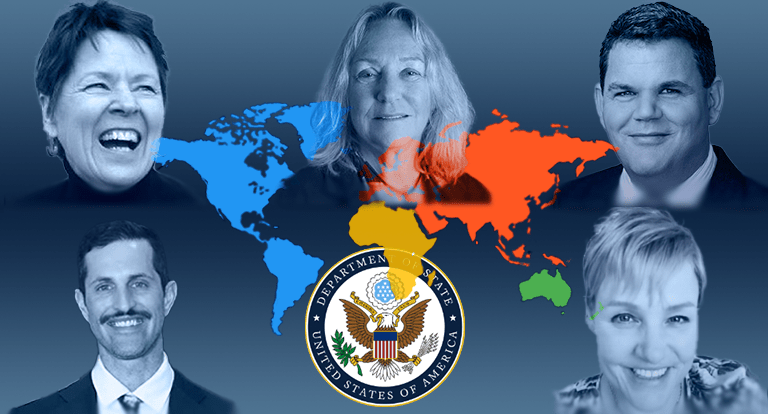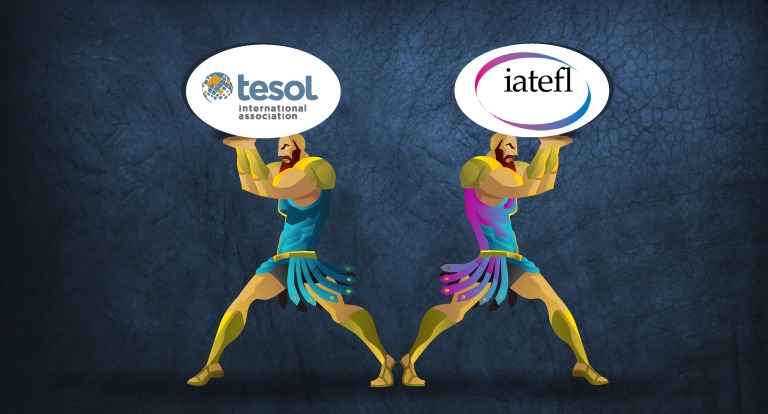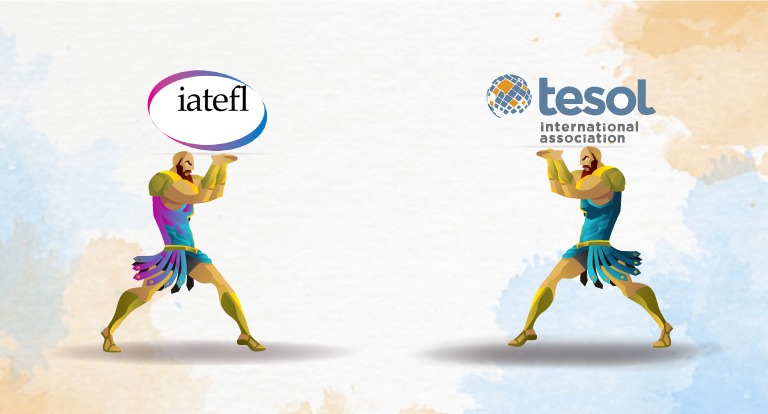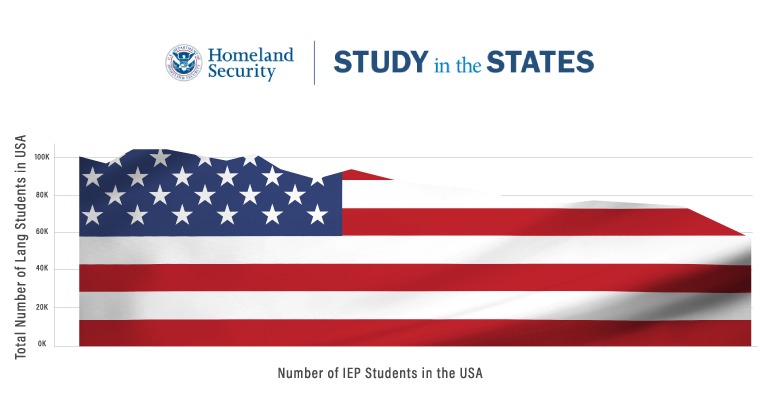— Our Blog —
Global ELT News
Get the latest ELT news! Our international network of journalists are always on the hunt for the latest and greatest news in the English language teaching space around the globe, so you can stay informed. Hear about breaking industry topics, international trends and issues, and other news relevant to you and your career.
-
Leveraging English Proficiency Testing in Academics and Employment
By Linda D'Argenio
English language testing constitutes a significant part of the English teaching industry. Every year, millions of students take various tests to demonstrate their proficiency in English. To put this in...
-
From Talk to Text: What Peer Learning Really Builds
By Bridge
This is a guest post contributed by Bridge’s M.A. TESOL university pathway partner, University of St. Andrews. “Make sure you let the learners discuss their ideas before asking them to... -
How TESOL Specializations Shape Better Teaching and Learning
By Bridge
This is a guest post contributed by Bridge’s M.A. TESOL university pathway partner, Westcliff University. In a diverse world of English language teaching and learning, many pathways and specializations offer...
-
Navigating Today’s ELT Job Market: A Guide to Industry Trends and Expanding Niches
By Savannah Potter
The current English Language Teaching, or ELT, market is thriving both online and in schools around the world. With the growing number of opportunities comes more competition for the best... -
Choosing an LMS or Learning Platform for Your Online English Teaching Business
By Linda D'Argenio
Are you an independent online English teacher with a growing private tutoring business? Until now, you may have used free video-conferencing software and handled student management and administrative tasks on...
-
Adaptive, Data-Rich, and Immediate: The New Language Assessment Powered by AI
By Shélynn Riel
Language assessment is undergoing a profound transformation, driven by the rapid advancements in Artificial Intelligence (AI). In an era where language skills are more crucial than ever for academic, professional,... -
Pedagogy First: Frameworks for Integrating Technology and AI With Purpose in ELT
By Shélynn Riel
Technology has long been a fixture in English Language Teaching (ELT), from cassette tapes and language labs to mobile apps and adaptive platforms. But in today’s educational landscape, where generative...
-
AI-Enhanced Speaking Practice: A New Era in Personalized, Real-Time, and Immersive Language Learning
By Shélynn Riel
In the rapidly evolving landscape of English Language Teaching (ELT), artificial intelligence (AI) is increasingly reshaping how educators and learners approach language acquisition. One domain experiencing a noteworthy shift is... -
BBELT 2025 Highlights: Innovation, Adaptability, and Growth in ELT
By Ricardo Cifuentes
The 2025 BBELT Conference brought together English teaching professionals from around the world in a rich, all‐online setting. Centered around the theme “Shaping Brighter Futures Through ELT,” the event was... -
The Future of English: In Conversation With David Crystal
By Rashmi Chugani
What’s the future of English in our hyper-connected, tech-driven world? Renowned linguist and author David Crystal shared his thoughts on the state of English as a global language and its... -
The Rise of Business English as a Lingua Franca: Trends in Business English and Corporate Language Training
By Shélynn Riel
By 2030, the global English Language Training (ELT) market is projected to reach $129.3 billion, reflecting a 7.5% compound annual growth rate. A key contributor to this growth is the... -
Integrating Technology With Purpose: Key Takeaways From Educast International Conference 2025
By James Padgett
Technology is present in most, if not all, areas of our lives. This reality creates a necessity for educators to compete for their students’ attention by engaging them in content... -
Connecting Teachers Globally: Insights From the 2025 Macmillan Global Teachers’ Festival
By Ricardo Cifuentes
The 2025 Macmillan Global Teachers’ Festival brought together teachers from all over the world. For ten days, experts shared ideas, teaching methods, and new trends in education. The sessions covered... -
Teaching Smarter, Not Harder With AI-Powered Content Creation
By Shélynn Riel
As technology becomes more integral to education, generative AI is transforming how English Language Teaching (ELT) professionals approach lesson planning, activity creation, and resource development. This new wave of AI... -
Preply: An Innovative Platform Empowering Teachers and Connecting Learners Worldwide
By Rashmi Chugani
Since 2012, Preply has been on a mission to make language learning more effective and accessible for everyone. The platform was founded by Ukrainian entrepreneurs Kirill Bigai, Dmytro Voloshyn, and... -
The Case for Celebrating Fluency in Conversational English
By Gustavo Fróes
There has been an unprecedented shift in the global landscape of English language education worldwide. Schools and organizations have increasingly prioritized conversational fluency over rigid grammatical perfection, recognizing that effective... -
Tech-Driven Solutions: Learn About Global Language Assessment Provider Bright Language
By Rashmi Chugani
A pioneer in language assessment, Bright Language has been a preferred language proficiency assessment provider to organizations around the world for more than 30 years. An early adopter of advancing... -
The Importance of Transferable Skills for ESL/EFL Students
By Jennifer Maguire
In today’s rapidly evolving world, the ability to adapt, communicate effectively, and solve problems creatively is more important than ever. For ESL students, transferable skills are crucial for success in... -
The Rise of CLIL in Global Education Systems
By Jennifer Maguire
In a globalized world, multilingualism has become increasingly important. In response to this, the progressive educational approach of Content and Language Integrated Learning (CLIL) is seeing global adoption as a... -
Global Perspectives: EF’s 3rd Annual Online English Teacher Conference
By Krzl Light Nuñes
Keeping online English teachers abreast of timely issues and the latest tech and online teaching methodologies, EF Teach Online held its 3rd Annual Online English Teacher Conference on June 21st.... -
Tech-Driven Transformation: How Technology is Revolutionizing English Language Teaching
By Jennifer Maguire
The language learning market is vast, and like so many other industries, it’s evolving with technological advances. Language learners are today’s largest cohort of learners around the globe with one... -
PTE: A Testing Success Story
By Rashmi Chugani
The Pearson Test of English (PTE) launched worldwide in 2009. Since then, it has become a leading exam for study applications worldwide, and for visa applications for work and migration... -
Introducing the Teacherpreneur Academy: Empowering Educators to Launch an Independent Teaching Career
By Savannah Potter
A new kind of entrepreneur has arrived and is changing the landscape of online English language teaching. The teacherpreneur is an independent educator, driven business owner and lifelong student. These... -
From Teaching Abroad to Teaching Online: Rise of the Digital Nomad
By Savannah Potter
A new day breaks and online English teacher Andrea Beatriz Collados settles in at her desk in her home in Buenos Aires, Argentina to start a new day of teaching.... -
Debunking the Methodology Myth: Identifying Multiple Methods of ESL Instruction
By Linda D'Argenio
Choosing an effective foreign language teaching methodology is a concern common to many language teachers. In the case of teaching English as a second or foreign language, this concern is... -
No Teacher Left Behind: An Empowering 19th BRAZ-TESOL Conference
By Krzl Light Nuñes
With a spotlight on equipping the English language teaching community with the skills, tools, and best practices for current and future trends, BRAZ-TESOL convened ELT educators from Brazil and abroad... -
Demand for Business English Continues to Grow Exponentially – Learn the Ins and Outs of This Lucrative ELT Niche for Teachers
By Shélynn Riel
In today’s competitive world, acquiring proficiency in the English language has become essential, and learning Business English is fast becoming a necessity, as English is the lingua franca, the international... -
Post-COVID Online English Language Market Sees Continued Growth
By Jennifer Maguire
Denver, Co – The global English language learning market is growing, but the market segment to watch in the coming years may be the online learning component of the industry.... -
From Decolonizing ELT to Embracing Multimodal Approaches, IATEFL 2023 Delivered Calls to Action
By Shélynn Riel
I arrived at Harrogate station feeling contemplative and eager to experience my first IATEFL conference. The view from the train into the North Yorkshire, England town of Harrogate is idyllic... -
We Plan, You Teach: A Closer Look at ESL Lesson Plan Companies
By Jennifer Maguire
ESL lesson plan companies offer ready-made resources for teachers Denver, Co. – The aphorism “time is money” may sound pithy, but teachers know the value of time – and how... -
Upskilling Opportunities for ELT Industry Grow With Global Shifts, Rise of Private Sector EFL Companies
By Jennifer Maguire
Denver, Co – If you work in education, you’re likely immersed in a culture that greatly values continued professional development, or CPD. In recent years, this idea of continuous growth... -
Get to Know ESL Pals: The Company Designing Lesson Plans for Teachers!
By Bridge
In this interview, Raedmund Gibbons, one of the founders of ESL Pals, explains what his lesson planning company offers ESL teachers. 1. Hi, Raedmund! Could you tell us, what is... -
Global, Digital Evolution Drives Need for 21st-Century, Transferable Skills in Today’s Employees
By Jennifer Maguire
ESL teachers must prepare students to apply multiple resources and competencies for 21st-century global, digital exchanges Denver, CO – If you work in education, you’ve heard the phrase “21st-century learning... -
More Connected Than Ever: Taking Advantage of Global ELT Associations’ Online Offerings
By Shélynn Riel
Since ELT is a global industry, it’s common for teachers to travel the world and teach in various contexts. However, despite forming part of a global industry, English teachers often... -
Big Business: High-Stakes English Tests Drive ELT Test Prep Solutions
By Jennifer Maguire
Denver, CO. – As the remote delivery of English language tests becomes more commonplace, resources to prepare test takers have evolved as well. Gone are the days of visiting a... -
How English Tutor Marketplaces Are Continuing to Evolve
By Gerald Smith
Whether you are an independent online tutor, an ESL/EFL teacher at a language school or a language school owner or manager, a good grasp of ELT marketplaces is essential for... -
Online English Language Testing – Increased Access Comes With Security Challenges
By Jennifer Maguire
Denver, Co. – English language testing has long been used for a variety of purposes, such as hiring and promotions, college and university admissions and immigration. The shift to online... -
IATEFL CONFERENCE 2022
By Gerald Smith
Everyone eagerly put real faces to names they knew only from Zoom calls or Linkedin. Walking into the hall of the 55th International Association of Teachers of English as a... -
Large, Global ELT Publishers Innovate To Meet Evolving Needs
By Jennifer Maguire
Denver, Colo. U.S. – Today’s English Language Teaching industry is evolving, and global ELT publishers must continue providing content and resources to meet the needs of this fast-changing field. The... -
Do English Language Schools Invest in Teachers’ Continuing Professional Development?
By Katharina Schmidt
Continuing professional development is generally considered a cornerstone of education careers, yet English Language Teachers at language schools around the world often lack professional credentials and only pursue the minimum... -
English Testing at Home: Convenient and Safe, but Is It Accessible (and Acceptable) to All?
By Michele DeBella
When established, test-development leaders discuss their online English proficiency tests, similar themes emerge. Online tests, most of which can be taken at home, have a wider reach than computer-based tests... -
What’s It Like to Teach English for the US Department of State? Voices from the Field
By Dorothy Zemach
The purview of the United States Department of State, more commonly referred to as the State Department, is vast. Broadly responsible for international relations and foreign diplomacy, this executive department... -
Bridge Launches English Teacher Empowerment Scholarship to Support Global Educators
By Katharina Schmidt
Due to the COVID-19 pandemic, many English language teachers (ELTs) lost work and had to make significant cuts in their personal and professional lives, including in their own education. To... -
The New Frontier of Teaching English: Interactive, Global, Virtual and Innovative!
By Ivana Segvic-Boudreaux
Online instruction made its presence known in the world of education decades ago. However, mobile applications, originally purposed for productivity assistance, are now being used for more than just playing... -
Is It Your Mission to Teach English?
By Nicolle Okoren
Natalie Goff, 50, has lived in Nicaragua teaching English as a Christian worker for eight years now with no immediate plan to leave. When the man she was dating told... -
What Is the Current State of English Teaching in Afghanistan?
By Dorothy Zemach
Freshta Noori was 11 years old when she started studying English in the fourth grade. She was 19 when she began teaching English while simultaneously working on her teaching certification.... -
Will English Language Teachers Be Traveling Again in 2022?
By Michele DeBella
Though the coronavirus pandemic has been a global event, its impact has been uneven, varying across borders and within communities. Industries everywhere, particularly those that rely on travel, have suffered,... -
English Language Teaching Start-ups: Will the Next ‘Unicorn’ Speak English?
By Nicolle Okoren
“Alternative language learning companies are attracting investors and reaching ‘unicorn’ status, a term used in the venture capital industry to describe a privately held startup company with a valuation of... -
From English Language Learners to Teachers: Busting the Native-Speakerism Bias
By Andrea Nyilas
These are game-changing times for hiring professionals in the field of English language teaching (ELT). English is one of the key languages shaping the modern world and the language itself... -
Are Machine Translation Tools a Threat to English Teaching?
By Dorothy Zemach
If you have long passages, DeepL does come up with language that is more natural overall. But DeepL often mistranslates words and shorter phrases. When Google Translate first launched in... -
The Philippines: Emerging From a Sea of Language Learning Destinations
By Katharina Schmidt
The rising demand for English teachers worldwide has provided Filipinos with much-needed employment opportunities and significantly affected other ESL (English as a Second Language) industry stakeholders. Large corporations profit from... -
America’s English Language Teaching Initiatives: What Impact Are US Tax Dollars Making Globally?
By Mia Samaniego
In 2020, $730.7 million was distributed to educational and cultural exchange programs, which includes English language initiatives, according to the U.S. Department of State Fiscal Year 2020 Agency Financial Report.... -
Is Online ESL Education Here to Stay? English Language Teachers Discover Creativity, Opportunity Within Pandemic’s Restrictions
By Ivana Segvic-Boudreaux
At the start of the pandemic, the world came to a halt. Formerly bustling cities were suddenly marked by empty streets, closed businesses, shut down schools and at-capacity hospitals. The... -
Up and Running: How the Pandemic Is Reshaping Business English Instruction
By Jessica Zimmer
Business English instruction has become less centralized and more global, with more learners seeking spots in online classes and an increase in the use of digital materials. Several months into... -
Going Viral – Can English Language Educators Monetize Their Teaching Through YouTube?
By Dorothy Zemach
Last month, BridgeUniverse explored the ways English language teachers and learners are using Instagram and TikTok. In this article, we’ll continue looking at English teaching outside the classroom by profiling... -
Quakes in the Landscape of China’s English Language Education System
By Loren Chiesi
For many years, just having a “white” appearance and a European or North American accent was enough to get an entry-level English teaching position at learning centers around the world.... -
The Titans of ELT (Part Two): Defining Diversity and Inclusion Within IATEFL and TESOL
By Loren Chiesi
In part one of our series comparing the International Association of Teachers of English as a Foreign Language (IATEFL) and the TESOL International Association, we explored the structures, challenges and... -
Learning Anywhere, Anytime: Will Apps Make English the Lingua Franca of the 21st Century?
By Andrea Nyilas
The concept of English learning is all around us. Opportunities to learn languages at our workplaces or in our communities serve as ways to bring people together and to provide... -
IATEFL and TESOL: The Two Titans of ELT (Part One)
By Loren Chiesi
For over 50 years, TESOL International Association (commonly referred to simply as TESOL) and the International Association of Teachers of English as a Foreign Language (IATEFL) have been the two... -
Teaching English With TikTok? How Social Media Is Making Microlearning Big Business
By Dorothy Zemach
Microlearning — instruction delivered in short, bite-sized chunks — has become increasingly popular in the corporate world for in-service training. Although the term was coined back in 1963 by Hector... -
ELT Entrepreneurs Come to Bridge as YLAI Fellows, Leave as Leaders
By Vicki Colbert
Although cliché, there’s a Roman proverb that still rings true with many thriving entrepreneurs: “Luck happens when preparation meets opportunity.” Raquel Castro knows that feeling entirely. At 10-years-old, she acquired... -
Bridge Partners With Latin American Governments to Support English Teacher Development
By Catarina Chase Aleixo
Education systems in Latin America are prioritizing English language proficiency as a necessary skill for graduates to be equipped for success in an increasingly globalized world, according to a report from... -
U.S. Intensive English Programs: Short-Term Volatility or Long-Term Decline?
By Jean-Marc Alberola
Intensive English Programs (IEPs) in the United States provide English language instruction to international students and visitors. Traditionally, this has been primarily through Academic English programs, offering preparation for study at... -
English Test Providers Jockey for Position as Pandemic Accelerates Online Trend
By Nick Thomas
Luis von Ahn, the co-founder and CEO of Duolingo, had to travel to the neighboring country of El Salvador to sit his English language proficiency exam for a U.S. college... -
Are ‘SIGs’ the Unsung Heroes of English Teacher Associations?
By Vicki Colbert
There are many reasons to join a global or regional community of English language teaching professionals. Membership to the International Association of Teachers of English as a Foreign Language (IATEFL)... -
Spitting Rhymes in the Classroom: Bridge Partners With Lo-Fi to Mix Hip-Hop and EFL
By Catarina Chase Aleixo
In 2019, Miles Iton found himself in a classroom full of Taiwanese sixth graders who were looking on as he put together his entire DJ set-up at the front of... -
Pipe Dream or Possibility? Moving Abroad to Teach English During the Pandemic
By Catarina Chase Aleixo
Missouri resident, English teacher, and blogger, Kristin Blake, has wanted to move to France since high school when her French teacher introduced her to French language and culture. She made... -
Online ELT Marketplaces: How They Work, What They Charge & How to Make the Most of Them
By Catarina Chase Aleixo
When thriving language–learning app, Busuu, acquired video-tutoring language marketplace, Verbling, back in mid-January 2020, it was perhaps not fully aware of quite how prescient its “double-digit million dollar acquisition” had been. At... -
ELT Conferences Go Virtual: Is This the Future for Industry Events?
By Vicki Colbert
Each year there are an estimated 80 or more ELT (English Language Teaching) conferences across the globe. They come in all shapes and sizes. Many are grassroots events organized by teachers volunteering... -
Native Speakerism: Discriminatory Practice or Response to Market Demands?
By Catarina Chase Aleixo
English has become the world’s first truly global language. It is the global lingua franca for business, diplomacy, and tourism; it is the unofficial first language of the Internet; and... -
Marek Kiczkowiak of TEFL Equity Advocates Takes on Native Speakerism
By Bryn Bonino
Marek Kiczkowiak has been in the ELT field for over ten years and now runs TEFL Equity Advocates & Academy which helps English teachers worldwide tackle “native speakerism” and teach English...












































































